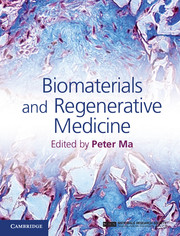Book contents
- Frontmatter
- Contents
- List of contributors
- Preface
- Part I Introduction to stem cells and regenerative medicine
- Part II Porous scaffolds for regenerative medicine
- Part III Hydrogel scaffolds for regenerative medicine
- Part IV Biological factor delivery
- Part V Animal models and clinical applications
- 25 Bone regeneration
- 26 Biomaterials for engineered tendon regeneration
- 27 Advancing articular cartilage repair through tissue engineering: from materials and cells to clinical translation
- 28 Engineering tissue-to-tissue interfaces
- 29 Models of composite bone and soft-tissue limb trauma
- 30 Tooth development and regeneration
- 31 Dentin–pulp tissue engineering and regeneration
- 32 Dental enamel regeneration
- 33 Hair follicle and skin regeneration
- 34 In-vitro blood vessel regeneration
- 35 Stem cells for vascular engineering
- 36 Cardiac tissue regeneration in bioreactors
- 37 Bladder regeneration
- Index
- References
32 - Dental enamel regeneration
from Part V - Animal models and clinical applications
Published online by Cambridge University Press: 05 February 2015
- Frontmatter
- Contents
- List of contributors
- Preface
- Part I Introduction to stem cells and regenerative medicine
- Part II Porous scaffolds for regenerative medicine
- Part III Hydrogel scaffolds for regenerative medicine
- Part IV Biological factor delivery
- Part V Animal models and clinical applications
- 25 Bone regeneration
- 26 Biomaterials for engineered tendon regeneration
- 27 Advancing articular cartilage repair through tissue engineering: from materials and cells to clinical translation
- 28 Engineering tissue-to-tissue interfaces
- 29 Models of composite bone and soft-tissue limb trauma
- 30 Tooth development and regeneration
- 31 Dentin–pulp tissue engineering and regeneration
- 32 Dental enamel regeneration
- 33 Hair follicle and skin regeneration
- 34 In-vitro blood vessel regeneration
- 35 Stem cells for vascular engineering
- 36 Cardiac tissue regeneration in bioreactors
- 37 Bladder regeneration
- Index
- References
Summary
Enamel formation
Enamel is the outermost covering of vertebrate teeth and the hardest tissue in the vertebrate body. During tooth development, ectoderm-derived ameloblast cells create enamel by synthesizing a complex protein mixture into the extracellular space where the proteins self-assemble to form a matrix that patterns the woven hydroxyapatite (Wang et al., 2007; Zhu et al., 2006). During enamel biomineralization, the assembly of the protein matrix precedes mineral replacement. The predominant protein of mammalian enamel is amelogenin, which is secreted from ameloblasts. It is a hydrophobic protein that self-assembles to form nanospheres that in turn influence the crystal type, organization, and packing of the crystallites (Du et al., 2005). In contrast to the mesenchyme-controlled biomineralization of bone, which uses collagen and remodels both the organic and the inorganic phases over a lifetime, enamel contains no collagen and does not remodel. The mature enamel composite contains hardly any protein (Smith et al., 1998) and is a tough, crack-tolerant, and abrasion-resistant tissue (White et al., 2001).
The process of enamel formation, termed amelogenesis, is the end product of a series of complex, dynamic, and programmed cellular, chemical and physiological events (Simmer et al., 2010). Enamel formation can be categorized into three distinct stages – the secretory, transition, and maturation stages. The secretory stage is characterized by active protein synthesis and secretion by the ameloblasts. Ameloblasts also deposit enamel crystals at oblique angles while they are moving in the direction of the future cusps to accommodate expansion of the enamel surface. The transition stage is of short duration and is characterized by extensive apoptosis and shortening of ameloblasts in preparation for their transition into the maturation stage. The maturation stage is characterized by removal of enamel organic materials and growth of hydroxyapatite crystals in thickness, as well as by regulated movement of ions into and out of the enamel matrix (Lu et al., 2008; Smith et al., 1998). Besides their involvement in crystal formation, ions also contribute to the color of the teeth (Yanagawa et al., 2004). Enamel in humans is characterized by a large diversity of color variations.
- Type
- Chapter
- Information
- Biomaterials and Regenerative Medicine , pp. 583 - 589Publisher: Cambridge University PressPrint publication year: 2014
References
- 1
- Cited by



